Case Study
Renowned Research Hospital Relies on 3T MRI + Sentient Suites to Achieve Results
Case Study
Renowned Research Hospital Relies on 3T MRI + Sentient Suites to Achieve Results
Boys Town National Research Hospital has a unique set of needs when it comes to their Magnetic Resonance Imaging (MRI) capabilities.
An internationally recognized leader in clinical and research programs focusing on childhood deafness and related communication disorders, the Omaha, Nebraska-based institution had two primary goals when choosing their MR suite:
You're reading Cassling's Case Study on Boys Town National Research Hospital. Prefer a PDF? Click the button below!
They weighed multiple options before ultimately choosing a Sentient Suite built around a 3T MRI. The Sentient Suite is an interactive MR room that uses video image displays, touch controls, LED lighting, sound systems and easy storage to ensure the patient is at ease during procedures. What’s more, it can slip into a more research-focused environment at the push of a button.
In this Cassling Case Study, the people who use the Sentient Suite every day share their insights and explain why this is the right choice for Boys Town Hospital now and in the future. You’ll find out how Boys Town Hospital uses its Sentient Suite to achieve its MRI research goals, provide an exceptional experience for standard patient examinations and increase scan volume. You’ll also learn how Boys Town’s Center for Neurobehavioral Research is using this state-of-the-art MR room as the centerpiece for groundbreaking research into how neurologists and other physicians diagnose and treat childhood trauma.*
“It doesn’t make any difference if you have the best equipment. If your patient is unable to hold still, you can’t take the picture.”
That’s Sue Smith, BSRT (R)(M)(MR), Director of Imaging Services at Boys Town National Research Hospital. She and her clinical staff pride themselves on their ability to get an accurate image for the radiologist to use in a diagnosis. To do that, they need their patients to be as still as possible. That’s difficult for many adults, but it’s exponentially harder with children.
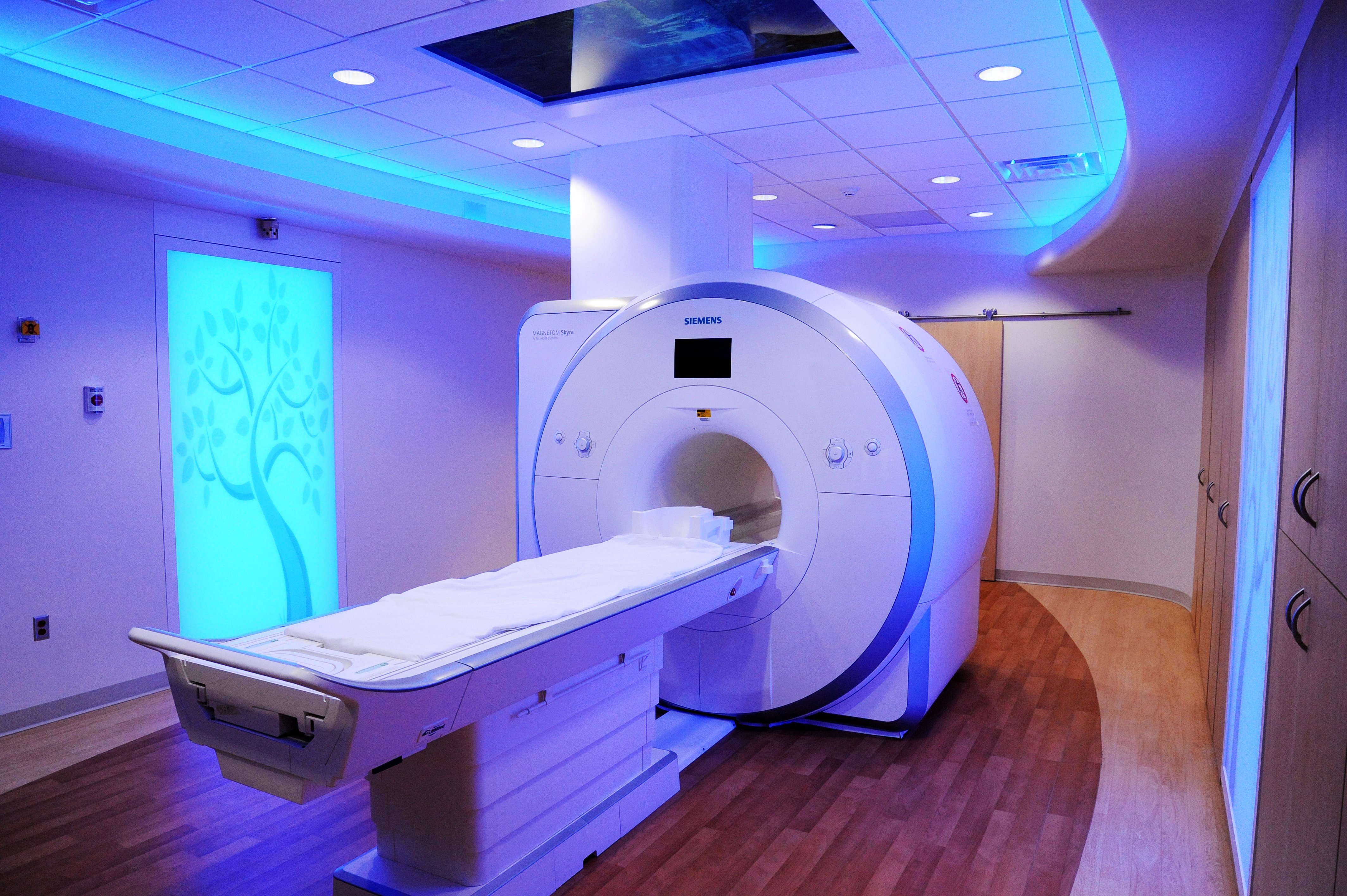 |
| The MRI suite at Boys Town National Research Hospital features video image displays, touch controls, LED lighting, sound systems and easy storage. Available through Sentient Suites, the room was designed to give patients control of their environment and create an unrivaled patient experience. |
At many hospitals and clinics, sedation is the answer. But for Boys Town Hospital, which does everything in their power to make the situation comfortable for the patient, sedation was yet another step that can cause exam times to increase and reduce available volume at the facility. Some sedations are certainly necessary, but they like to avoid them when they can.
That’s where the Sentient Suite comes in. As part of the MR suite’s innovative technology, the patient can choose what kinds of videos or photos they’d like to look at during the exam, select the music they’d like to listen to and talk to the technologist or their parent the entire time. This is important for a facility like Boys Town Hospital, which primarily images children.
“Especially for doing special needs, this really helps,” said Ron Copsey, CT/MRI Technologist at Boys Town Hospital, as he scrolled through the photo and video options that came with the display. “It changes depending on preference. You could see the ocean. We have kids’ scenes, the zoo, some underwater filming, the clouds, redwoods, a lot of people love the space scene with the stars. Sometimes there’s music that comes through the background. The patient can, for example, view the ocean and hear waves, so that’s very relaxing to some.”
These video options are in addition to choosing the ambient colors the children would like to see in the immediate environment of the suite itself. Kids also appreciate the opportunity to listen to music.
“Kids really like that. We have iHeartRadio or Pandora, or they can listen to KidzBop. We’ve preloaded a lot of them. That saves us time because it really distracts them.”
Plus, because of the abundant storage capabilities of the Sentient Suite, Boys Town Hospital is able to keep the wires and intimidating equipment out of sight as the child is brought into the room – something else that goes a long way toward alleviating anxiety.
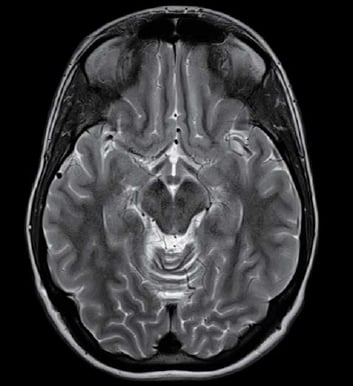 “The nice thing about this suite,” said Ron, “is we have barn doors in the back, which are large enough to store all of our equipment. The ventilator and the monitor are kept there so, when we bring kids in, they’re not seeing all these contraptions. All our coils can basically fit in that room so it doesn’t look as intimidating.”
“The nice thing about this suite,” said Ron, “is we have barn doors in the back, which are large enough to store all of our equipment. The ventilator and the monitor are kept there so, when we bring kids in, they’re not seeing all these contraptions. All our coils can basically fit in that room so it doesn’t look as intimidating.”
Taken together, this creates an experience that’s far less overwhelming than the typical MR exam.
And that brings us back to sedation. The various aspects of the Sentient Suite have combined to have an outsized impact on Boys Town Hospital’s ability to carry out scans without the need to sedate the patients.
“I’ve scanned children eighteen months to four or five years old, and your success rate depends on the kid**,” said Ron. “But if they’re ten or twelve, they can probably hold still for what we’re going to do. The pictures are awesome.”
“A lot of our patients do have developmental or behavioral issues,” said Sue. “So this MRI suite is wonderful. Our failure rate is very low. Almost everybody that comes in here gets it done.”
The Sentient Suite has enabled them to get to more patients than ever while helping ensure those patients don’t need to return for a re-scan.
“We recently achieved a record month,” said Sue. “The most MRs we’ve ever done.”
To illustrate the difference this makes on an individual level, Ron provides one recent example.
“Just the other day, we had an 18-month old,” he said. “The parents commented to me the experience here was much better than their previous facility. We were able to screen them, bring the parents into the room, and this little child did awesome. An 18-month old, with no sedation. We had the iPod and mom and dad were able to stay right with him. The mom tapped on his chest and we made it through.
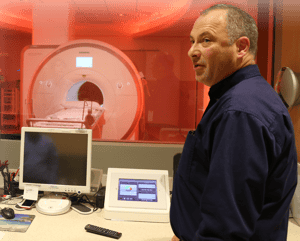 “I’ve been doing this for a long time. I have a good feel in the 40 years I’ve been doing this, by looking at the patient, by looking at the parents, what kind of success rate we’re going to have. Did the lights and the music make a difference? Yes. Because we were able to change the colors in the room. I went through the color wheel, it was like a rainbow, and it mesmerized the kid for a little while, so that was great. That’s the kind of stuff that we hear from patients. So yes, it does make a difference.”
“I’ve been doing this for a long time. I have a good feel in the 40 years I’ve been doing this, by looking at the patient, by looking at the parents, what kind of success rate we’re going to have. Did the lights and the music make a difference? Yes. Because we were able to change the colors in the room. I went through the color wheel, it was like a rainbow, and it mesmerized the kid for a little while, so that was great. That’s the kind of stuff that we hear from patients. So yes, it does make a difference.”
Sue and Ron are quick to point out that it’s not just patients who have experienced the positive benefits of the Sentient Suites technology. This has also drawn praise from clinical staff at Boys Town Hospital and elsewhere.
“Not only is the patient calmer,” said Sue, “but in other settings you get the anesthesiologist and nurses in here and things can be kind of hectic. But we’ve got a calm environment that is not filled with clutter, and people can just get their job done and it helps the providers, too.”
Sue and Ron explain that 100 MRs in a month is pretty common, with seven to eight patients per day being about the maximum. Much of their patient volume comes from in-house radiologists and physicians, who recognize their expertise and research leadership. For their needs, conducting scans is not a volume game, and that’s by choice. As they explain, however, this particular 3T MRI gives providers the option to increase volume dramatically if they so choose.
“Depending on the exams you’re doing, you could probably get 10 to 12 patients in per day easily,” said Ron. “Our protocols are pretty long. Our radiologists are adamant about what they want and their sequences, so we’re not cutting corners. We’re here because of the patient, so we definitely have to keep that in mind. A lot of the protocols we do are a little bit longer, but that’s because we try to do it the right way.”
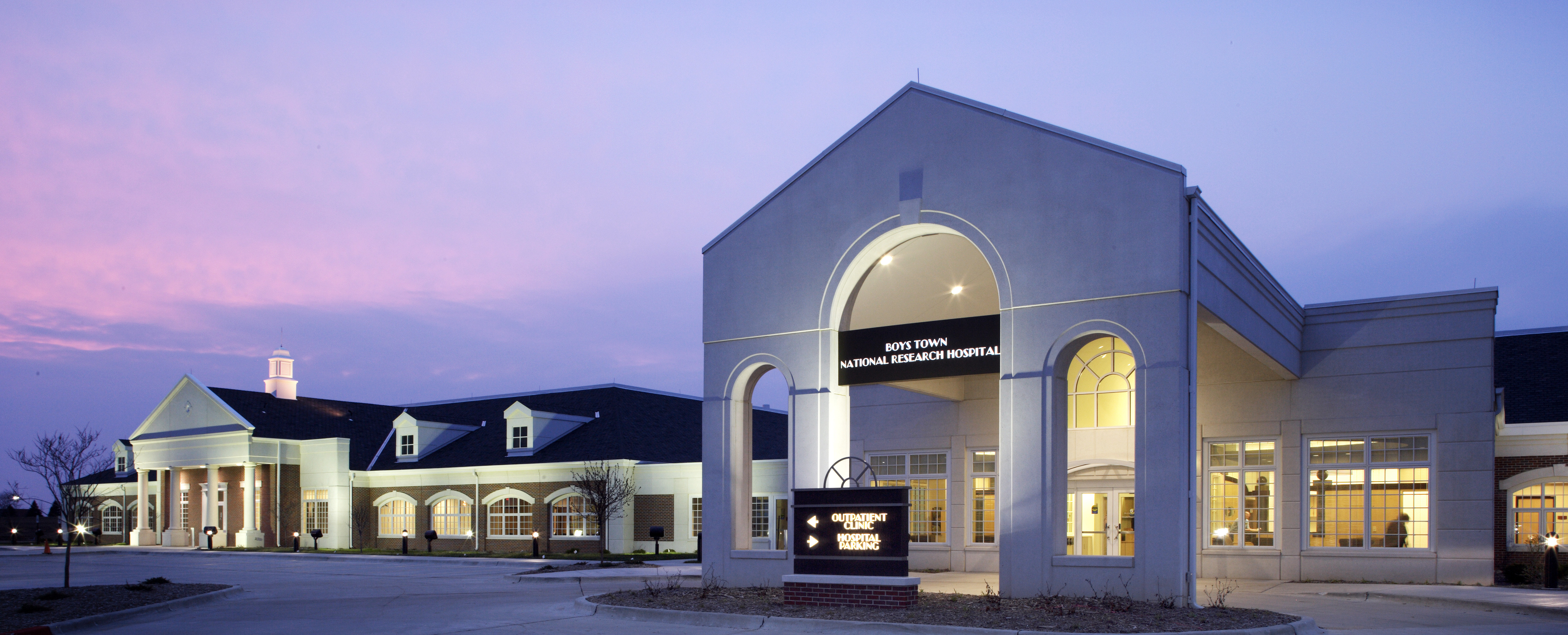 |
| Based in Omaha, Nebraska, Boys Town National Research Hospital is dedicated to providing leading edge clinical care, pioneering translational research resulting in advanced diagnosis and treatment, and improving the lives of children and families through technology and educational outreach programs. |
“The culture at Boys Town Hospital is much different than the culture at other places,” said Sue. “The doctors are much more involved in making sure that their patients get in, that there’s no waiting, that everyone is treated, not rushed, that it’s done correctly. They read the reports very carefully and they will call the radiologist for questions. If there is anything unusual, they will call me. It’s like a small town. It’s a whole experience, from the moment they walk in to the moment they leave.”
Because of their dedication to the patient experience, it’s not uncommon for technologists to carry out multiple examinations on a single patient. Or, as is often the case, the radiologist may pull the images up in real-time, communicating to the technologist any changes they need. That’s yet another way they can keep from having to rescan patients, and it’s all possible through the use of the Sentient Suite with the 3T MRI.
Word has gotten out about what Boys Town Hospital is capable of, and physicians in the area are responding enthusiastically to the results they’ve seen. In fact, some have even elected to go with the Boys Town MR suite over their own health system!
“This is a great scanner as far as neuro work, brains and spines; the pictures are very nice,” said Ron. “I know that doctors at one local neurological clinic have said that our images are so good that, even though they have their own magnet, they’re fine with their patients coming here because they know the work that we do.”
“Our doctors and our researchers are constantly bringing people through here all the time for tours,” he continued. “That in itself does a lot of marketing. Word of mouth from the people they bring in is as helpful as anything.”
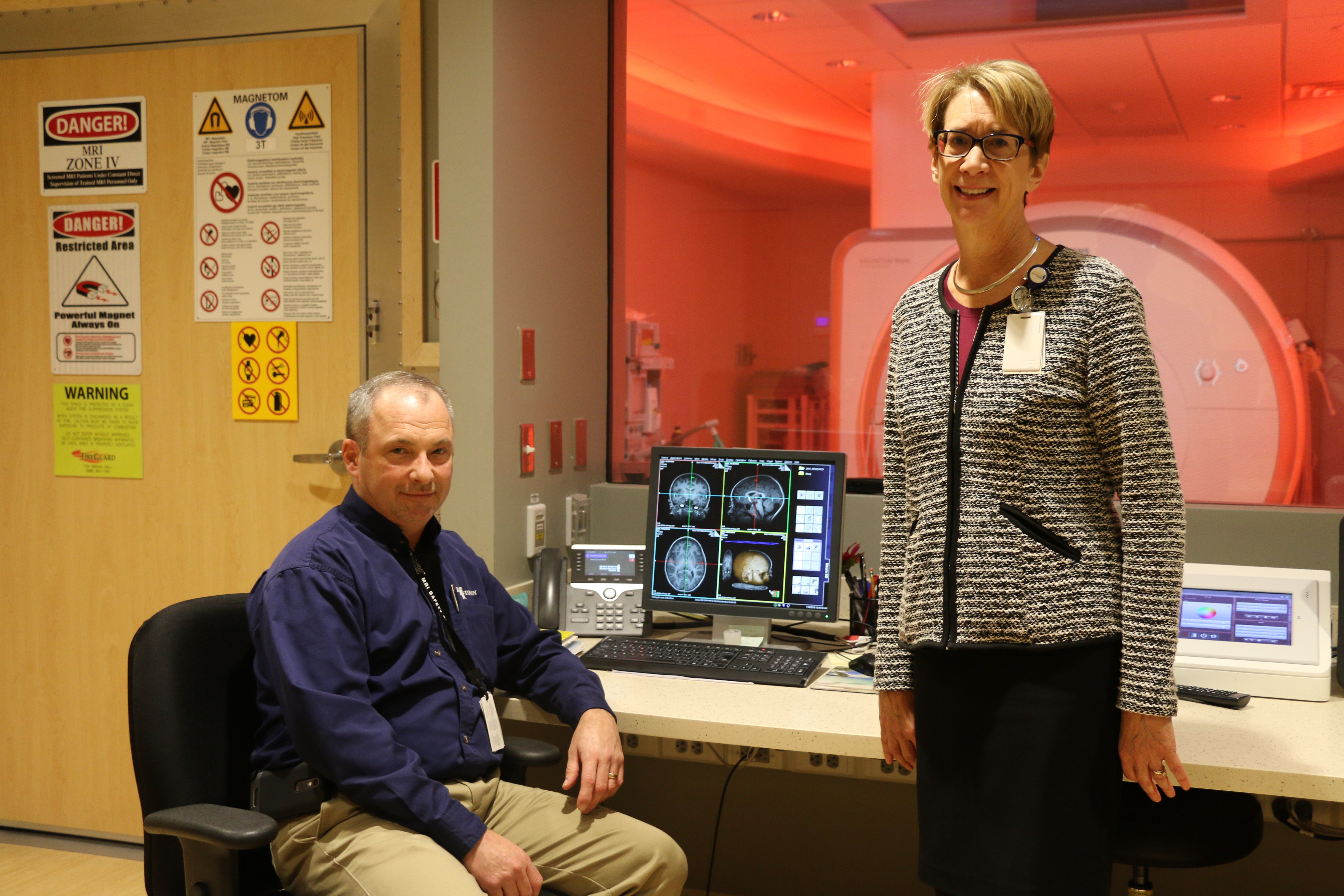 |
| Sue Smith, BSRT (R)(M)(MR), Director of Imaging Services (right), and Ron Copsey, CT/MRI Technologist (left), pose in the MRI suite at Boys Town National Research Hospital in Omaha, Nebraska. |
The MR and the work it allows Sue and her team to carry out has been a boon for fundraising efforts, something that’s critical for Boys Town Hospital, a nonprofit research hospital.
“When fundraising for Boys Town Hospital and especially for Dr. James Blair and his research (more on that in a bit), they bring in donors,” said Sue. “They’re always showing them this. Dr. Blair comes in and talks about his work, and it’s fascinating to hear about what they are doing with the kids.”
“I think our quality speaks for itself with this magnet,” said Ron. “Once they see this, we really don’t have a problem because we can do as good of work as anybody with this magnet.”
And although they’re not focused on volume for volumes’ sake, the team at Boys Town Hospital has also been able to bring procedures in-house that they previously would have had to refer elsewhere. That’s helped them establish trust with patients and physicians alike.
“In the past, we would say, ‘No, we’d rather not try that,’” said Ron. “But Sue says, ‘let’s just try. We can do these things and do a good job at it.’
“We’ve gotten more progressive. We’re pleasing the physicians by telling them ‘yes, we’ll do it, we’ll give it a try.’ We’ve started to do more abdominal work and special stuff that you wouldn’t really expect here. We’ve had an enterography and other equipment, and with one neurosurgeon that’s come on, we’ve had special sequences set up just for him. We’ve gotten a lot more progressive in trying to keep the physicians happy, to keep the referrals here.”
“And in my defense,” said Sue, “I would never expect Ron or anyone to do something they are not familiar with. We bring in apps and we get training and Ron is very good about calling and getting protocols from other places or calling the helplines.”
“If we call the helplines and say, ‘hey, we’re going to do this,’ they can remote in and help us with the protocol,” said Ron. “That’s very nice because we can make sure once again that we’re doing the right thing. They’ve been able to help us with that.”
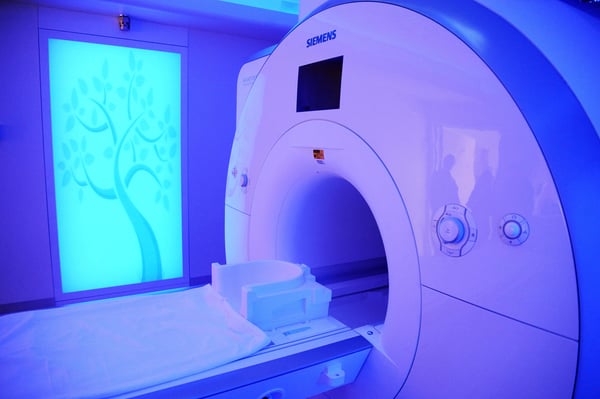 Research That Makes a Difference
Research That Makes a Difference“If you see Spider Man, you want to press the button. If you see the Green Goblin, you don’t press the button.”
That’s James Blair, Ph.D., Director of the Center for Neurobehavioral Research, and no, he’s not explaining how to order comic books. As part of his work, he conducts MR scans of children who have experienced trauma or substance abuse. By studying the images of their brains while they see different stimuli, his goal is to gain a better sense of how trauma affects children and lingers in their brains for years to come, which in turn will help professionals establish protocols to help them cope with that trauma over time.
Back to Spider-Man and the Green Goblin. Dr. Blair explains:
“They lie down on the bed [within the MRI] and there is a helmet that goes over the head. We try to keep the person as still as possible without making them uncomfortable. There’s a projector in the MRI room that is hooked up to our laptop and projects the games they are playing onto the mirror system in the helmet, which the individual then looks at.
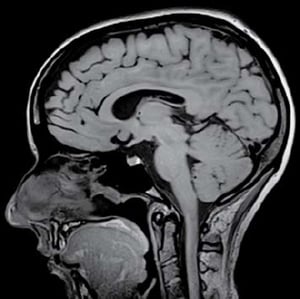 “They have a button box in their hand, and they press the buttons when they’re looking at things. In the classic form, it’s called a go-or-no-go task. If something is good, you press the button, and if something is bad, you don’t press the button. We have a child-friendly version of that task where we use Spider-Man and the Green Goblin as our stimuli.
“They have a button box in their hand, and they press the buttons when they’re looking at things. In the classic form, it’s called a go-or-no-go task. If something is good, you press the button, and if something is bad, you don’t press the button. We have a child-friendly version of that task where we use Spider-Man and the Green Goblin as our stimuli.
“The go-no-go task is a standard response control paradigm, so we’ve just slightly adapted it. By doing this, we can look at sensitivity to frequency of command as well as sensitivity of actually holding back or not holding back.
“We have another task that helps evoke an emotional response. It’s called the looming paradigm. Basically, it involves a face or an animal that either looks like it’s coming toward you, because the picture becomes bigger across the visual field, or as if it’s running away from you because it gets smaller. Using that kind of task, we can see the extent to which somebody shows an overly exaggerated or under-responsive signal to threats.
“We tend to see, at a very crude level, that individuals who are significantly more at risk for self-harm show an exaggerated response. And individuals who are significantly more at risk for engaging in aggressive behavior over a period of time are more likely to have a reduced response. It’s these types of associations that we are looking for.”
This and other research is made possible through the use of what the staff at Boys Town Hospital have dubbed the Sentient Suite’s “Research Mode.” With the flick of a button, the technologist can turn the environment from what we described above to something that fits the needs of researchers.
“They [researchers] want everything white, the brightest light,” said Ron. “They keep it that way because it’s important to keep everything the same for research purposes. So, we basically have a research button that turns everything bright for them. The top lights and panel side lights will come on, and these can lights turn a little brighter."
Researchers like Dr. Blair appreciate the room’s versatility. He’s currently in the midst of a years-long project that evaluates the neural responses of youth residents at Boys Town who are getting care and treatment for behavioral and mental health problems. As such, he relies on the to provide an accurate, detailed image.
“They come in and we see them shortly after their arrival, and then we see them shortly before their departure, so that we can look at and compare the neural signatures pre-Boys Town intervention and post-Boys Town intervention. We do four sessions before and four sessions afterwards, so we get a pretty broad spectrum relating to the types of moods and conditions that are common here.
“Most of the kids here come in with externalizing conditions of ADHD, OCD, and mood and anxiety conditions of all sorts is very common. In addition, about 40% have suffered significant trauma, and about 40% percent have suffered or engaged in significant substance abuse.
“Our primary focus over the first two years of our existence at Boys Town Hospital has been: What is the impact of trauma and what is the impact of substance abuse? Showing the differential patterns for cannabis versus alcohol with regards to the impact on the brain. Or showing the differential neural signature patterns for different forms of maltreatment. Physical abuse impacts the brain very differently than sexual abuse, for example.”
By establishing patterns that manifest following instances of trauma or substance abuse and then gauging how these patterns have been altered, researchers will be able to evaluate the effectiveness of the therapies being done at Boys Town, thereby allowing counselors, pharmacologists and other experts to adjust their prescribed treatments as needed.
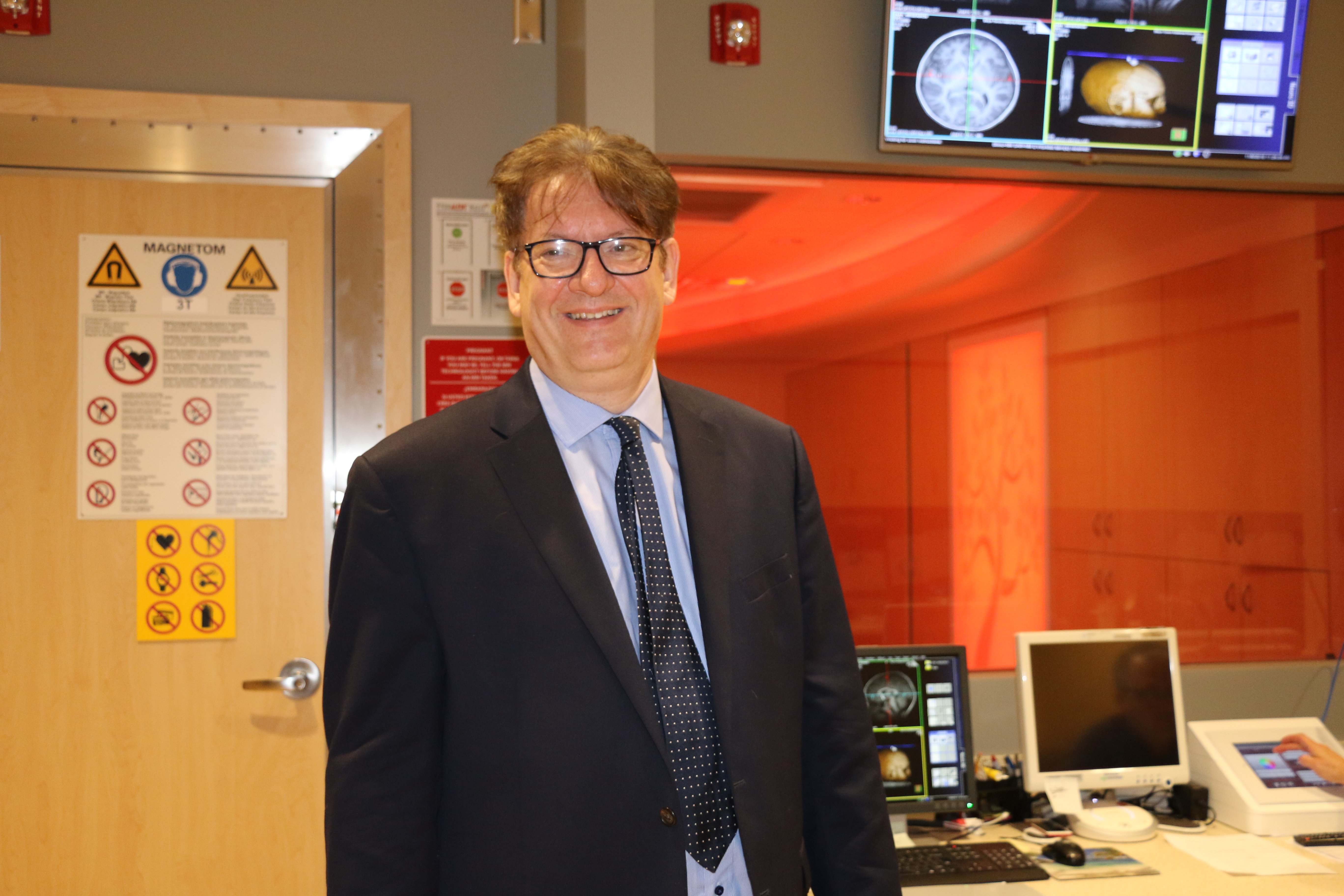 |
| James Blair, Ph.D., Director of the Center for Neurobehavioral Research, uses MRI to study pediatric brain activity and gain a better sense of how trauma affects children and their treatment plans. |
“The idea is that each of those neural signature patterns, as we start to get them, become more and more refined, and we can use them as a signal to see the extent to which Boys Town’s intervention ameliorates that problem.”
“We certainly can say that for the average adolescent coming into Boys Town, when we scan them 12 months later at the end of their stay, there are indeed changes in neural signature. It appears that there are changes back toward a more healthy level following the months that the adolescents have been in Boys Town with respect to reward-responding and with respect to threat processing.”
As Dr. Blair and researchers gauge the ways different areas of the brain light up on the scan, it can be a sort of roadmap for potential trauma. If they can establish commonalities between scans, they might even be able to reverse-engineer the patterns to diagnose children who aren’t forthcoming about the trauma they’ve experienced.
Imagine a neurologist who can look at MR images and, based on the readings, tell a psychiatrist that the child likely suffered from a certain form of abuse that is manifesting in specific ways. This would open up avenues of exploration to ultimately help the child cope with that trauma in a healthy way.
“What we’re really hoping to do, with the machine learning techniques that are available for statistical analysis now, is to translate this group level of data into individual participant data. So we can say, if you’ve experienced sexual abuse, for instance, your scans will look like this, so we’re pretty confident this kid has experienced sexual abuse given this particular profile.”
“More critically, we could see the extent of the problem that child is facing subsequent to that sexual abuse. For example, we want our data to be able to tell us the chances of this child exhibiting self-harming behavior. Is it at 20 percent risk or 80 percent risk? This will help guide clinical decisions for treating that child."
Dr. Blair explains that evaluations to this extent are still a few years away, but the early results are promising.
In the near future, Boys Town National Research Hospital plans to continue its mission to use research to change the way America cares for children and families.
The Sentient Suite is a centerpiece of much of that research, with Dr. Blair and others utilizing it to achieve groundbreaking results in new areas of neurologic study. At the same time, Sue and her team expect to continue to see record-breaking numbers of monthly scans thanks to the streamlined workflows of the MR and the relaxing environment that surrounds it.
Sue herself puts it best when describing the Sentient Suite’s capabilities:
“You can have the best machine in the world, you can have the best tech in the world, but if the patient can’t hold still because of anxiety, it doesn’t matter. It’s nice to have great equipment and great techs, but you still need a good environment.”
That’s what the Sentient Suite has helped them achieve, and with plans to build another MR suite in the works, it will continue to be a cornerstone of Boys Town National Research Hospital’s exceptional work and unmatched patient experience for years to come.
*The statements by the customer described herein are based on results that were achieved in the customer’s unique setting. Since there is no “typical” hospital and many variables exist (e.g., hospital size, case mix, level of IT adoption) there can be no guarantee that other customers will achieve the same results.
**MR scanning has not been established as safe for imaging fetuses and infants less than two years of age. The responsible physician must evaluate the benefits of the MR examination compared to those of other imaging procedures.

Join our list to be the first to learn about educational events and product/industry news.

Copyright © 2025 Cassling
All Rights Reserved.
Privacy Policy. Compliance Policy.
EEO Policy.